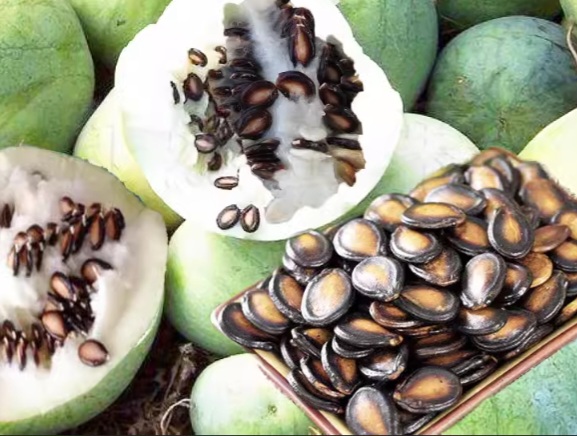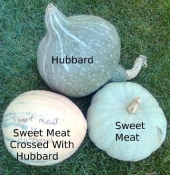
 5
5




“Knowledge is knowing a tomato is a fruit: Wisdom is not putting it in a fruit salad. “ Brian Gerald O’Driscoll
 7
7




Love is the only resource that grows the more you use it.
David Brower
 8
8




 7
7




Permaculture...picking the lock back to Eden since 1978.
Pics of my Forest Garden














Olga Booker wrote: According to the legend, Lady Godiva rode naked, I guess that's why they called these hull less seed producing pumpkins by that name!!
“Knowledge is knowing a tomato is a fruit: Wisdom is not putting it in a fruit salad. “ Brian Gerald O’Driscoll










 1
1




Jan White wrote:One thing about hulless seeds is they're more prone to rotting in cool, wet soil, so that might be something to keep in mind for your conditions. You might need to seed more heavily, plant a little later, grow in raised beds. If you want to develop a landrace, I'd go with seed more heavily.
Every pepo variety of squash I've ever grown has had nice eating seeds, even with the hulls on. The hulls are thin, so you can just eat them. Maxima varieties have thick, woody hulls that are unpleasant to eat, and, yeah, it's not really worth cracking the hulls off the individual seeds.
I've never heard of any varieties of hulless seeds with a particularly high seed count or vitamin/mineral content. I think they're all pretty similar.
You can also eat watermelon and cucumber seeds. Watermelons are a little fibery, but cucumber seeds are quite nice. I'm talking seeds from fully mature fruit, not picked at eating stage.
“Knowledge is knowing a tomato is a fruit: Wisdom is not putting it in a fruit salad. “ Brian Gerald O’Driscoll










 2
2




Greg Martin wrote:There are also varieties of hull-less pumpkins that have been bred for much better quality flesh, such as 'Naked Bear', that you might want consider for inclusion into your landrace.
“Knowledge is knowing a tomato is a fruit: Wisdom is not putting it in a fruit salad. “ Brian Gerald O’Driscoll
 4
4




Living a life that requires no vacation.
 4
4




 4
4




Sarah Elizabeth wrote:
I did not know that lots of the pepos had edible seeds. When you say they are edible even with the hulls on, do you mean eating them at harvest stage or even when they are dried out?
 6
6




Greg Martin wrote:There are also varieties of hull-less pumpkins that have been bred for much better quality flesh, such as 'Naked Bear', that you might want consider for inclusion into your landrace.










 3
3




Jan White wrote: Dried out. The hulls get thin and crispy. Eaten fresh, the hulls still have a bit of chew to them. And some are better than others. I've never had any I didn't want to eat, though. I seem to remember the best were from some crooknecks that fully matured in my neighbour's garden while they were away. I raided a bunch of stuff from them that year :) They usually ended up tilling half their unharvested garden under at the end of the year anyway.
“Knowledge is knowing a tomato is a fruit: Wisdom is not putting it in a fruit salad. “ Brian Gerald O’Driscoll

 5
5




It is a privilege to live, work and play in the traditional territory of the Salish People.
Now drop and give me 52... ~ Come Join the permies Shoecamp! ~ All about Permies, including Tutorials ---
Twenty bucks off the homesteading bundle for the next 72 hours!
 7
7




Jan White wrote: Maxima varieties have thick, woody hulls that are unpleasant to eat, and, yeah, it's not really worth cracking the hulls off the individual seeds.










 3
3




s. lowe wrote:I use. Them for the seed oil.
Stacy Witscher wrote: Regardless, hull-less seeds will make a smoother pumpkin seed butter.
jordan barton wrote: In my experience they grew to be big and would require a large knife to cut through them.
It meant about 10-15 minutes per pumpkin to get them out and washed and to remove the pulp.
Ellendra Nauriel wrote: If you sprout the seeds from C. maxima, mixta, or moschata, the shells come off easily. You can choose how long to let them sprout before eating, whether it's just until the shell can be peeled off or if you want to wait until the seedling-leaves open.
“Knowledge is knowing a tomato is a fruit: Wisdom is not putting it in a fruit salad. “ Brian Gerald O’Driscoll
 4
4




Sarah Elizabeth wrote:
Ellendra Nauriel wrote: If you sprout the seeds from C. maxima, mixta, or moschata, the shells come off easily. You can choose how long to let them sprout before eating, whether it's just until the shell can be peeled off or if you want to wait until the seedling-leaves open.
Sprouting: what a great idea. I'd completely overlooked that possibility with moschata etc.

 6
6




Hans Albert Quistorff, LMT projects on permies Hans Massage Qberry Farm magnet therapy gmail hquistorff
 6
6




Permaculture...picking the lock back to Eden since 1978.
Pics of my Forest Garden
 4
4






Permaculture...picking the lock back to Eden since 1978.
Pics of my Forest Garden
 5
5





Zone 6, 45 inches precipitation, hard clay soil





|
On top of spaghetti all covered in cheese, there was this tiny ad:
The new kickstarter is now live!
https://www.kickstarter.com/projects/paulwheaton/garden-cards
|





